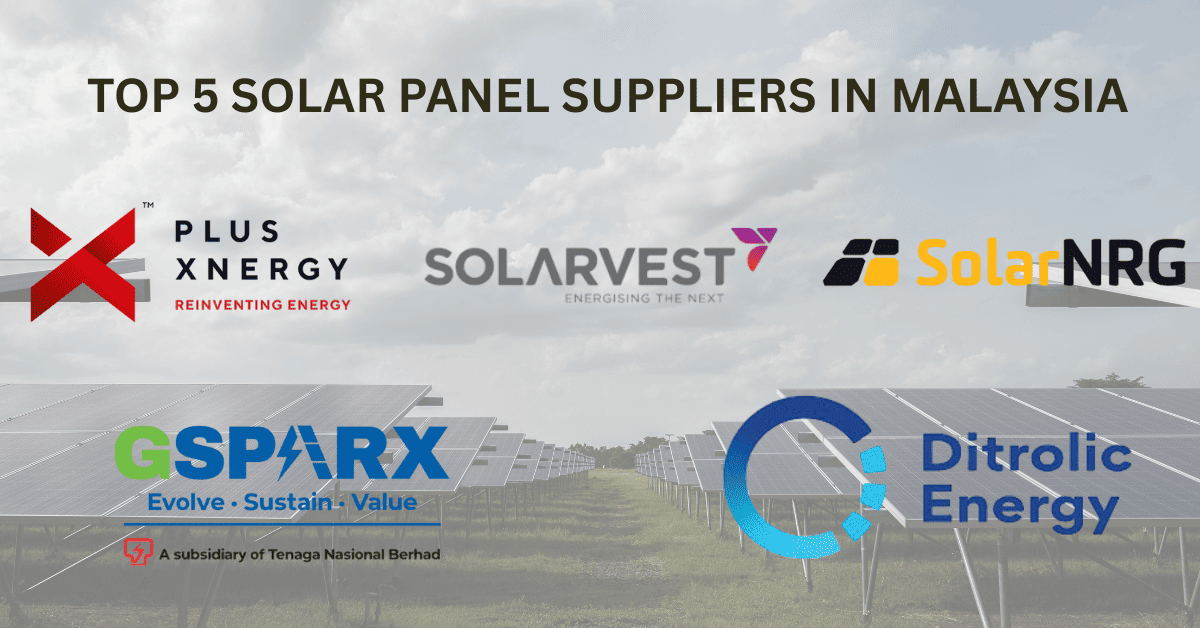Solar adoption in Malaysia has grown rapidly, thanks to generous subsidies and incentives by the government.
But recent policy updates and market changes mean choosing the right supplier is more important than ever.
Whether you’re planning to offset your TNB bill with a solar panel for home or want to sell excess electricity to make a quick buck, this guide compares the top 5 solar panel suppliers by service, supply, and long-term savings potential.
Here’s what you’ll find in this 2025 July blog comparison:
- TNB buyback eligibility & Net Energy Metering updates
- Residential solar panel capacity guidelines
- Government grant options for home solar
- Supplier-side pros, cons, and pricing insights
Compare Malaysia’s Best Solar Panel Suppliers (2025)
Supplier | Best For | TNB NEM Support | Grant Help | Panel Capacity (Residential) | Price Range |
Plus Xnergy | All-in-one smart solar | Full onboarding | Yes | Up to 10 kWp | RM20K–RM60K |
Solarvest | SME & home owners | Yes | Yes | 4–12 kWp | RM18K–RM55K |
SolarNRG | Modular European system | Yes | Limited | 3–6 kWp | RM15K–RM35K |
Ditrolic Solar | Industrial & custom fit | Yes | Yes | Up to 12 kWp | Varies |
GSPARX (TNB) | Zero Capex model | Integrated | Built-in | 4–6 kWp (under financing) | RM0 upfront* |
*GSPARX offers leasing-based solar installation with no upfront cost, subject to agreement and usage.
Disclaimer: All pricing, system capacity, and service details in the table are based on publicly available information and supplier websites as of July 2025. Actual costs and features may vary depending on roof size, location, installation complexity, and updated TNB/NEM policies. Please contact each solar panel supplier directly for the most accurate and personalised quote.
1. Plus Xnergy
A trusted full-suite supplier with strong residential ROI and intelligent solar monitoring.
Plus Xnergy is one of the most recognisable names in Malaysia’s solar industry, offering both Tier-1 solar panels and its own proprietary energy management system called Xnergy Home. They supply panels, design systems, install, and help users register for TNB NEM and available rebates.
With their custom solutions, most landed homeowners can install up to 10 kWp, the maximum allowed for residential under TNB’s updated NEM3.0 framework.
- Ideal For: Residential owners seeking bundled monitoring, installation, and government grant help
- Known For: AI-powered dashboards, sleek install, high-efficiency panels
- ROI Estimate: 5–7 years (under NEM3.0, pre-2025 tariff)
2. Solarvest
One of Malaysia’s largest solar suppliers with complete in-house EPC capabilities.
Solarvest supplies solar panels directly through its vertically integrated operations, making them both a panel distributor and installer. Their size gives them access to wholesale pricing and better warranty coverage for consumers.
They’ve been actively helping Malaysians apply for government solar incentives, and their residential packages can reach up to 12 kWp, perfect for energy-hungry homes.
- Ideal For: Mid- to large-sized homes and business owners
- Known For: Fast project rollout, strong NEM/TNB paperwork support
- Trust Factor: Publicly listed on Bursa Malaysia
3. SolarNRG
A modular solar panel brand with European quality and scalable home systems.
SolarNRG originates from the Netherlands and operates a growing Malaysian branch. Unlike some EPC-only companies, they supply their own solar panel system catalogue (including Trina, JA Solar, and Jinko), giving customers brand flexibility.
Their strength lies in clean installation, transparency, and smaller residential systems that still qualify for NEM exports back to TNB.
- Ideal For: Urban homeowners with modest roof size
- Panel Range: 3–6 kWp ideal for most terrace and semi-D homes
- After-Sales: Dedicated support and performance monitoring tools
4. Ditrolic Solar
An experienced solar supplier and EPC with industrial-grade reliability.
Ditrolic has been active in the solar energy scene since 2009 and is known for controlling its own solar panel supply chain. While they serve large-scale projects, they also provide residential packages through verified partners or in-house teams.
They offer TNB onboarding, site feasibility studies, and ROI simulations to help you understand your payback period.
- Ideal For: High-consumption homes, bungalows, and businesses
- Known For: Clean energy engineering, custom system fit
- Panel Source: Multiple Tier-1 global manufacturers
5. GSPARX (by TNB)
Government-backed solar installer with zero upfront cost options.
Although not a traditional panel supplier, GSPARX offers one of the most accessible paths to going solar in Malaysia. As a TNB subsidiary, they manage the entire process, from panel supply to installation, to NEM integration using financing or leasing schemes.
In 2025, GSPARX continues to expand its “zero capex” plan, ideal for homeowners who want to reduce bills without paying RM30,000+ upfront.
- Ideal For: Homeowners looking for low-risk solar adoption
- Backed By: Tenaga Nasional Berhad
- Downside: You may not own the panels until lease ends
Still Unsure Which Supplier Fits Your Home?
Choosing the right solar supplier depends on your roof size, budget, and how much control you want over your system. Use this quick guide to help narrow it down:
Go With a Fully-Owned System If:
- You want to maximise long-term savings by owning the system outright
- You’re comfortable with an upfront investment (RM15K–RM60K)
- You want full control over the panels, output, and energy export
- You plan to stay in the same home for at least 6–10 years
- You qualify for SEDA/State solar rebates and want to claim them directly
Best Picks: Plus Xnergy, Solarvest, SolarNRG, Ditrolic Solar
Choose a Zero-Upfront Plan If:
- You want to start saving on your TNB bill without spending upfront
- You’re okay with a longer contract or lease-to-own agreement
- You want a hands-off setup handled by a licensed solar EPC
- You’re unsure how long you’ll live in the home but still want lower bills
- You don’t want to worry about maintenance or system repairs
Best Pick: GSPARX (by TNB)
Ask Yourself These Key Questions:
- Can your roof fit at least 4 kWp worth of panels? That’s the minimum for meaningful savings under NEM.
- Do you plan to export electricity back to TNB? Not all systems maximise this anymore under the new 2025 rules.
- Are you eligible for any 2025 solar grants? Some states still offer rebates, but not all suppliers will help you claim them.
If you still are uncertain, give one of the suppliers a call and ask them about the details. We recommend GSPARX, due to the TNB backing.
What Changed on 1 July 2025 for Solar Panel Users?
As of 1 July 2025, TNB and the Ministry of Energy Transition and Water Transformation (PETRA) have confirmed updates to Malaysia’s solar offset structure under Net Energy Metering (NEM).
Good News: NEM Users Still Get Offset for 3 Components
Contrary to initial concerns, domestic solar users will continue to receive full offsets for:
- Energy Charge
- Capacity Charge
- Network Charge
This applies to existing users under:
- MBIPV (Malaysia Building Integrated Photovoltaic)
- NEM 2.0
- NEM 3.0
For NEM 1.0 users, offset remains tied to displaced cost only.
“The latest announcement should ease concerns for the over 96,000 Malaysian households currently using solar power.” The Rakyat Post, 30 June 2025
How Long Will Offsets Last?
Programme | Offset Period | Ends |
MBIPV | 5 years | 31 Dec 2030 |
NEM 1.0 | 10 years | 31 Dec 2035 |
NEM 2.0 & 3.0 | 10 years from install date | Based on your solar PV setup date |
Example of New Electricity Tariff Breakdown (Post-July 2025)
Component | Rate (up to 1,500kWh) |
Energy Charge | 27.03 sen/kWh |
Capacity Charge | 4.55 sen/kWh |
Network Charge | 12.85 sen/kWh |
Total Offset | 44.43 sen/kWh |
Retail Charge | RM10/month (not offset) |
If you have a solar system and send extra electricity back to the grid (via NEM), you’ll earn credit based on the first three charges:
- Energy Charge: Cost of generating the power
- Capacity Charge: What it takes to ensure enough power is available
- Network Charge: Cost of delivering power through the grid
All of these add up to 44.43 sen per kWh, which is the value of your excess solar energy, as long as you use 1,500 kWh or less in a month.
Example: If your system sends 200 kWh back to TNB, you’ll get a credit of around RM88.86 (200 × 44.43 sen) on your next bill.
What Isn’t Offset?
The Retail Charge (RM10/month) is a fixed fee. Even with solar, this charge stays on your bill and can’t be offset with solar credits.
Other Important Updates for Solar Users in 2025
- NEM 3.0 Ended: Applications closed on 30 June 2025.
- SelCo (Solar for Self-Consumption) now replaces NEM 3.0 with:
- No more installed capacity limits
- 12-month settlement cycle standardised for all rooftop solar programmes
- Energy Efficiency Incentives (EEI):
- Monthly rebates of up to 25 sen/kWh for users consuming under 1,000kWh/month
- Lower rebate tiers for higher consumption
What It Means for You
- If you’re already in MBIPV or NEM 2.0/3.0, your ROI won’t drop, the full offset is still in place.
- If you’re planning new solar installations, SelCo offers more flexibility but no guaranteed export credit.
- Your chosen solar panel supplier must calculate returns based on this new tariff, not outdated rates or export assumptions.
Final Thoughts: Picking the Right Solar Supplier in 2025
Choosing a solar panel supplier in Malaysia is no longer just about price alone, it’s about system ownership, NEM eligibility, long-term support, and updated tariff impact.
If you want full control and faster ROI, owning your system through trusted suppliers like Plus Xnergy, Solarvest, or SolarNRG makes the most sense. They’ll help you navigate TNB approvals, claim government rebates, and install efficient Tier-1 panels with proven after-sales support.
If upfront cost is a barrier, GSPARX remains the most accessible way to go solar under a TNB-backed plan, especially if your household consumption stays below 1,500kWh.
But no matter which route you choose, make sure your supplier recalculates your projected ROI based on the new 2025 offset structure.
Just don’t rely on outdated NEM assumptions.
Legal Disclaimer:
All brand names, trademarks, and logos displayed on this website are the intellectual property of their respective owners. Their use herein is solely for descriptive and identification purposes. This website makes no claim of ownership, endorsement, or official association with any of the mentioned brands unless expressly stated.
Frequently Asked Questions About Solar Panel Supplier Malaysia
Most residential homes in Malaysia are allowed to install up to 10 kWp under TNB’s NEM3.0 guidelines.
Under NEM3.0, you export excess electricity to TNB and receive credit on your bill, now limited to Component A (energy charge) as of July 2025.
Yes, various government initiatives under SEDA or state programs may subsidise up to 20–30% of total cost. Your supplier can assist with applications.
It depends on your goal: Plus Xnergy for bundled smart solar, Solarvest for large installs, or GSPARX for no-cost entry.
Yes, all the top suppliers listed here provide TNB NEM onboarding, allowing you to sell unused solar energy back to the grid.
Costs range between RM15,000 and RM60,000 depending on your roof size, panel brand, and whether you qualify for rebates or lease programs.















